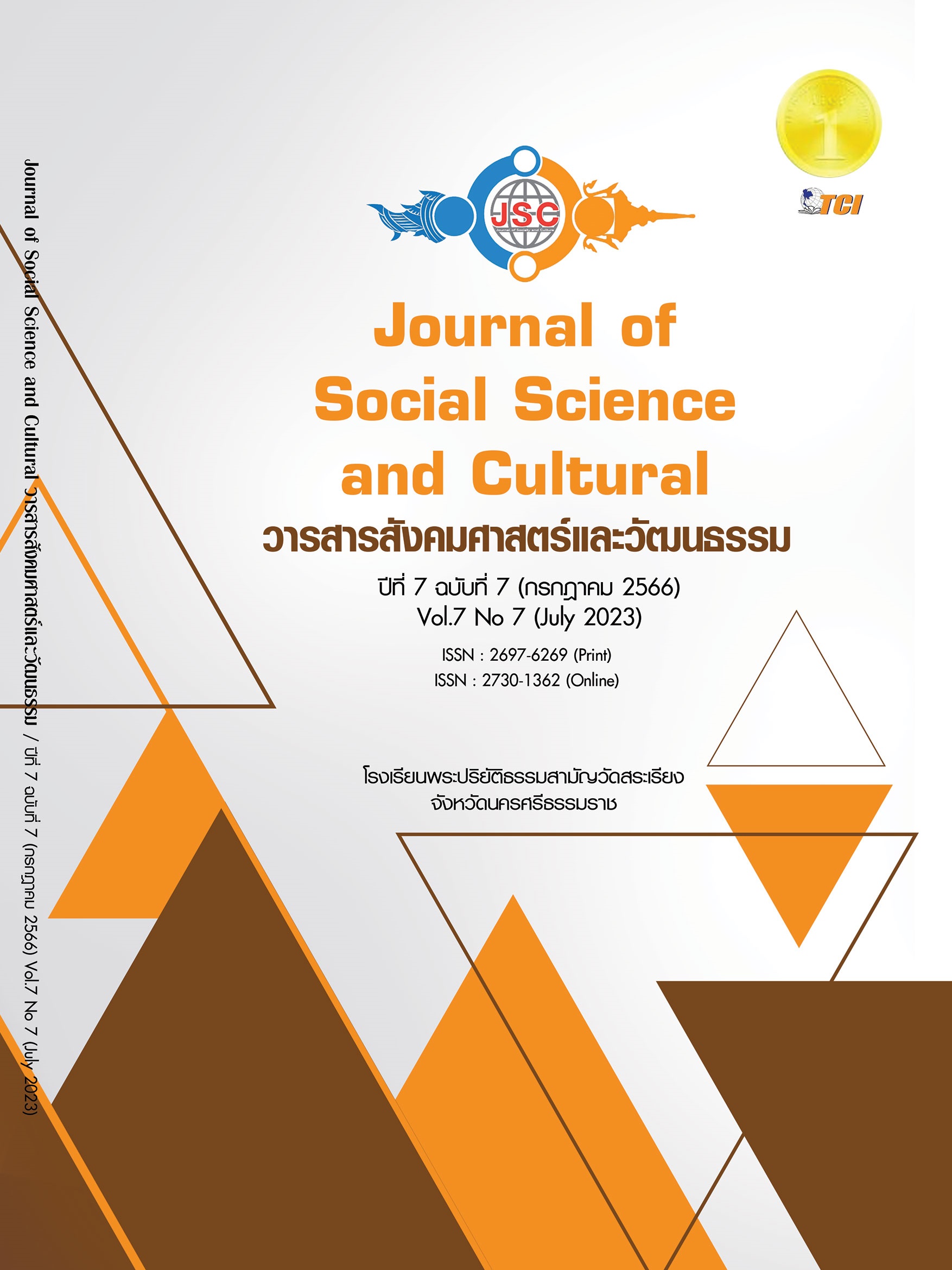EXPERIENTIAL LEARNING PROVISION WITH ASSISTIVE TECHNOLOGY TO IMPROVE ABILITY OF WHEELCHAIR MOBILITY CONTROL OF A CHILD WITH MULTIPLE DISABILITIES
Main Article Content
Abstract
The objective of this qualitative research was to investigate the effects of experiential learning management combine with the use of assistive technology to improve the mobility ability with wheelchairs of children with multiple disabilities. The case study was selectively targeted at 12-year-old male student with physical, mobility or health disabilities, and intellectual disabilities, who was studying at a preparatory level at a Special Education Center. Using qualitative research methodology. The research tools used included 1) a survey form for the current condition of the ordinary wheelchair used by the case study 2) an assessment of the ability to move and control the wheelchair of the case study before and after experiential learning according to Dewey’s learning cycle 3) an observation form for student behavior in the classroom during experiential learning combined with the use of assistive technology for wheelchair mobility of the case study 4) four units of experiential learning activities. The data were analyzed using mean, percentage, and standard deviation. The findings indicated experiential education management and wheelchair reconditioning of the case study. By adjusting the seat the backrest after the plastic canvas is padded with a solid sponge so that it doesn’t collapse when sitting and does not sag backwards when leaning against it make the case study sit back straighter. Adjust the footrest from a hard plastic board to a hard padded footrest to increase the height of the footrest to allow full foot rest and the stand is perpendicular to the floor at 90 degrees. Sent to case studies to be able to do learning activities in class able to carry out daily life independently without affecting the condition of disability. By being able to move from bed-wheelchair-floor and drive the wheelchair on a flat path for distance of 3 meters is of good quality. Able to drive a wheelchair on an incline over a distance of 3 meters and to drive a wheelchair on a different level are of fair quality.
Article Details
References
ทิศนา แขมมณี. (2558). ศาสตร์การสอน : องค์ความรู้เพื่อกระบวนการเรียนรู้ที่มีประสิทธิภาพ. (พิมพ์ครั้งที่ 19). กรุงเทพมหานคร : สำนักพิมพ์แห่งจุฬาลงกรณ์มหาวิทยาลัย.
ปฏิญญาว่าด้วยสิทธิคนพิการไทย. (2541). ปฏิญญาว่าด้วยสิทธิคนพิการไทย. เรียกใช้เมื่อ 16 มิถุนายน 2563, จาก http://www.braille-cet.in.th/Braille-new/?q=news-1278
พระราชบัญญัติการจัดการศึกษาสำหรับคนพิการ พ.ศ. 2551. (2551). ราชกิจจานุเบกษา. เล่มที่ 125 ตอนที่ 28 ก, หน้า 1. ( 5 กุมภาพันธ์ 2551 ).
ภาวิกา นพคุณ. (2561). การพัฒนาความสามารถนักเรียนที่มีความบกพร่องทางการเรียนรู้โดยการเรียนรู้จากประสบการณ์ วิชาคณิตศาสตร์ ชั้นประถมศึกษาปีที่ 1. ใน วิทยานิพนธ์การศึกษามหาบัณฑิต สาขาหลักสูตรและการสอน. มหาวิทยาลัยธุรกิจบัณฑิตย์.
ศูนย์การศึกษาพิเศษประจำจังหวัดลำปาง. (2563). หลักสูตรการพัฒนาทักษะการดำรงชีวิตของศูนย์การศึกษาพิเศษประจำจังหวัดลำปาง. ศูนย์การศึกษาพิเศษประจำจังหวัดลำปาง: สำนักบริหารงานการศึกษาพิเศษ.
สมพร หวานเสร็จ. (2556). การพิจารณาสนับสนุนเทคโนโลยีสิ่งอำนวยความสะดวกบริการและความช่วยเหลืออื่นใดทางการศึกษาแก่นักเรียน โดยใช้กรอบงาน SETT (SETT Frame work). เรียกใช้เมื่อ 4 กรกฎาคม 2563 จาก http://www.sedthailand.com/images/column_1292399425/frame%20sett2-web.pdf
สำนักงานเลขาธิการสภาการศึกษา. (2550). การจัดการเรียนรู้แบบประสบการณ์และเน้นที่การปฏิบัติ.กระทรวงศึกษาธิการ. กรุงเทพมหานคร: กระทรวงศึกษาธิการ.
องค์การอนามัยโลก. (2555). หลักสูตรอบรมการให้บริการรถนั่งคนพิการ คู่มือประกอบอบรมระดับพื้นฐาน.เรียกใช้เมื่อ 10 มิถุนายน 2563 จาก https://apps.who.int/iris/bitstream/handle/10665/78236/9789241503471_reference_manual_tha.pdf?sequence=60
องครักษ์ ธรรมมิกะ. (2561). มารู้จักท่านั่ง W-Sitting กันเถอะ. เรียกใช้เมื่อ 5 กรกฎาคม 2563 จาก http://www.pt.mahidol.ac.th
Dewey, J. (1938). Experience and Education. New York: Macmillan.
Rasmitadila, A. et al. (2019). Using Experiential Learning Model (ELM) to Slow Learner Students in the Science Lesson. Journal of Physics: Conference Series, DOI 10.1088/1742-6596/1175/1/012214
Rowland, C. (2012). Communication Matrix Questions and Answer Options. Retrieved May 25 , 2023, from https://aaccommunity.net/wp-content/uploads/2019/03/Communication-Matrix-Questions.pdf
Stanberry, K. & Raskind, M. H. (2008). Assistive Technology: A Parent’s Guide. London: GreatSchools Inc.


